Your most tough, healthy, no-spray roses?
I bought Annie L. McDowell for my sister in CA as a gift. She wasn't happy, citing that roses are too fussy & need chemicals. I gave roses to a neighbor, but she won't take them, citing that roses need spraying.
That's NOT TRUE, I have 150+ fragrant roses and I don't spray for decades.
Below are my 4 favorite always-healthy roses: Foreground is Annie L. McDowell, big white bush is Marie Pavie, white bush behind is Mary Magdalene, green bush to the right is Frederic Mistral (he blooms late). Picture taken June 6.
What are your most tough, healthy, no-spray roses? Thanks for info. about your soil and climate, to help folks choose appropriate roses.
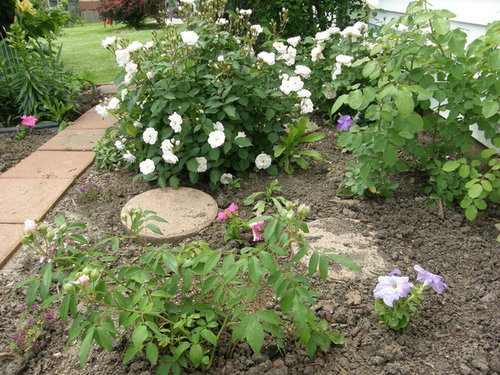
This post was edited by Strawberryhill (StrawChicago) on Tue, Jun 4, 13 at 15:49
Comments (57)
mendocino_rose
10 years agolast modified: 9 years agoThere are such differences in climate and soil that this becomes very difficult to judge. I could say that there are a lot of roses in my garden that do get a lttle disease but live through it. Consistently my Hybrid Chinas are without problems. My Albas are always clean.
strawchicago z5 thanked mendocino_roseogrose_tx
10 years agolast modified: 9 years agoNo spray at all here in Texas, but LOTS of mulch in my cement-hard clay soil, which has made all the difference. I have about 40 roses, the toughest of the tough are G Nabbonand, Souv de la Malmaison, Duchesse de Brabant, Maggie; in fact all are tough with the exception of Golden Celebration, who looks great through blooming, then pretty much gets defoliated with BS thereafter. This also happened with my Abraham Darby, chopped him down to nothing, and he has been very healthy ever since, go figure. Plan to do that to Golden Celebration and see what happens...
strawchicago z5 thanked ogrose_txRelated Professionals
Baltimore Landscape Architects & Landscape Designers · Mount Wilson Landscape Architects & Landscape Designers · Lantana Landscape Contractors · Elk Grove Swimming Pool Builders · Littleton Siding & Exteriors · Lowell Siding & Exteriors · Lake Oswego Landscape Architects & Landscape Designers · Tewksbury Landscape Contractors · West Haverstraw Landscape Contractors · Americus Landscape Contractors · Brooklyn Park Landscape Contractors · Cockeysville Landscape Contractors · Dallas Landscape Contractors · Hoffman Estates Landscape Contractors · The Villages Landscape Contractorsstrawchicago z5
Original Author10 years agolast modified: 9 years agoI agree with Mendocino that nothing works for everyone, since a rose behaves differently in different soil and climate.
Take Golden Celebration, it black spots for others, but it's 100% clean here, gets even better the 2nd year. Why? own-root Golden Celebration likes my alkaline clay soil, the root is huge ... it took me 1/2 hour to moved it.
Below is Golden Celebration in its 3rd year, after I moved it early spring into partial shade, 4 hours of morning sun:
{{gwi:261137}}
Christopher Marlowe is clean for others, and for me also. Picture taken this wet summer:This post was edited by Strawberryhill on Sat, Jun 15, 13 at 16:54
strawchicago z5
Original Author10 years agolast modified: 9 years agoI agree with Kate that Queen of Sweden is tough. It's green to the tip in my zone 5a winter, 100% clean. All Austins are clean in my soil pH of 7.7, except for Eglantyne with wimpy root ... that one needs dusting with whole-grain corn meal, pH 8, no salt, so it's better than baking soda.
Below is Queen of Sweden, taken after 30 hours of rain at optimal temp. for BS germination:
This post was edited by Strawberryhill on Fri, May 10, 13 at 20:54
jerijen
10 years agolast modified: 9 years agoI am in a coastal area of Southern California. Our conditions are more arid than semi-arid. Our water and soil are extremely alkaline, and also saline, as our hillside area is ancient seabed.
I'm sure that we once had topsoil, but over the eons, it has washed down onto the fertile Oxnard Plain. Nowadays there's nothing here but sterile silty-sand. Organic material for planting must be added. To be frank, our "native soil" is cr*p.
Though rain is scarce and growing scarcer, we commonly experience thick fog. Rain that we do get is confined to the winter months. We do not have summer rain. Anything we grow must be irrigated.
Roses that have problems, or require spraying in our conditions, do not stay here.
Our best roses are:
* "Grandmother's Hat"
* Gloire des Rosomanes ("Ragged Robin")
* Rosette Delizy
* Mons. Tillier
* Mme. Berkeley
* "Louise Ave. White HT" ('Snowbird')
* International Herald Tribune
Cecile Brunner
Perle d'Or
* Reve d'Or
* Secret Garden Musk Climber
Sombreuil, Cl.
*** RED CHINAS: Louis Philippe, "Bengal Fire", White Pearl In Red Dragon's Mouth, "Elisabeth's China," Cramoisi Superieur
Boule de Niege
Indian Love Call
Of the Austins, the two principal sucesses are Golden Celebration and Prospero
NOISETTES: See Reve d'Or (above); also
"Roseville Noisette" and
"Setzer Noisette"There are other things, but that's a good principal rundown.
Jeri
strawchicago z5
Original Author10 years agolast modified: 9 years agoThank you, Jeri, for the info. ... which makes me feel fortunate. I admire Jeri's love for roses despite her adverse conditions.
I agree with Ogrose' approach of pruning a rose really short to improve its disease-resistance. If the top growth is too big for the root to support, the plant will have problems not getting enough water and nutrients for optimal health.
2011 winter was the warmest in over a decade ... zero winter dieback. Cantigny rose park here looked worst in history: roses so tall, rampant diseases, and less blooms.
Below is Meilland hybrid tea, Firefighter ... it likes my alkaline soil and water, green to the tip in zone 5a winter, very healthy.
This post was edited by Strawberryhill on Tue, Jun 4, 13 at 15:54
jerijen
10 years agolast modified: 9 years agoYou know -- all it takes is the right roses. We keep roses that tolerate our conditions. Those that DON'T -- leave. If you select the right roses, they're easy.
Jeri
melissa_thefarm
10 years agolast modified: 9 years agoIt's true that no roses are good everywhere, and some that are excellent in one area may be abominable in another. Strawberry, if you can convince others that roses are easy to grow, if you choose the right varieties and give them basic maintenance, then you'll have improved the world. And they are easy. A question, do you object to low levels of disease, or it appearing at the end of the season? Many of my roses get a bit of black spot in fall when it begins to rain, but are otherwise clean, and I don't worry about it. Mild fungal diseases on roses are rather like colds in humans, not worth treating.
My ground is mostly very heavy clay, probably neutral to alkaline, amended, where I've done my work properly, with rotted hay and, when I can, with that rare and precious resource home-made compost. I mulch with hay and encourage annual herbaceous plants to grow among the roses, and return pruned material to the beds. Otherwise I don't fertilize. We have a Mediterranean climate, mild but chilly wet winters, often with a good deal of snow, and hot dry summers, cooler at night. We're in USDA Zone 8 but have enough chill hours to grow plants like cherries, tulips, and lilacs. Our average annual precipitation is about 40".
Roses in general like our conditions, and it's easier to talk about the ones that don't grow well, rather than the ones that do, as the latter are so many.
This is the native land of Rosa gallica and dog roses, and their close relatives the once-blooming old roses do very well here. They need the chill, don't mind summer drought, can handle the sodden winter soil and even being flooded at times while they're dormant. They actually prefer some shade, the Gallicas in particular, while the Albas and Damasks take full sun better. Close hybrids of the European once-blooming old roses also often do well: I have some good Portlands, Hybrid Perpetuals, and Hybrid Chinas. With the Teas and Chinas I have to be more careful about soil preparation: I lost two (perhaps three) that drowned in our last, amazingly wet winter. These do best with the soil much amended and terraced up somewhat for drainage, and with some protection from wind. I had a lot of breakage on the Teas this last winter as we had two unusually heavy snowfalls. The Banksiaes are fully hardy here.
Roses that don't do well here are the Rugosas, forms of Rosa moyesii, R. hugonis which falls prey to cane girdler, and I have reservations about R. spinosissima and its hybrids, but really ought to try them in better conditions. I lost R. omoiensis pteracantha to wet last winter. The Hybrid Musks like some protection from sun and positioning in the cooler and more humid parts of the garden. I haven't tried to grow many moderns and can't really say how they would do here, since I haven't given them a chance with adequately amended soil. Down in town Hybrid Teas thrive, but they have an alluvial soil there which is different from our clay.
Normally the only significant fungal disease here is mildew, which many of my roses get to some extent during the summer. It doesn't cause significant damage and I don't worry about it. Currently we're having the wettest spring on record and we have more fungal disease than usual. My experience has been that, when the anomalous weather passes, the disease goes away too. So I don't do anything.strawchicago z5
Original Author10 years agolast modified: 9 years agoThank you, Melissa, for your vast experience in Old Garden Roses. Years ago I checked in HMF and you grew 400+ in your garden. Now I checked and you downsized to 316+ roses, vast knowledge of Old Garden roses!
I appreciate the info. Melissa in Italy gives on the many classes of OGRs. Same here, some of my roses don't BS until November, then the winter takes all their leaves off, so who cares?
Thank you, Melissa, for debunking the bad rap that roses get, such as need spraying, fertilizer & water. You are right that clay doesn't need fertilizer ... that's how I killed 2 azaleas and 2 rhododendrons by acid fertilizer.
I also invited RRD mites to feast on one multiflora rose by spreading acid fertilizer high in nitrogen, which encouraged soft growth to feed mites and aphids. The high salt in chemical nitrogen fertilizer drives down potassium, necessary to fight diseases.
The info. that Melissa gives about what's best for each class of OGR is very useful. Likewise, I can say that Sonia Rykiel rose is a water-hog and prefers alkaline clay, but I can't say that she's disease-resistant, although she's green to tip through zone 5a winter.
She broke out in BS when I dumped acid fertilizer on the surface around her bush. That hole was amended with peat moss (pH 4) and alfalfa meal (pH 6). Then I moved her to alkaline clay, pH 7.7, with leaves at the bottom, and Sonia R. became clean and vigorous.
Alfalfa meal breaks down fast in Ingrid's dry and hot CA climate, which her loose soil gobbles that up. But alfalfa meal does the opposite in my wet and cold weather, where it gunks up on top of my heavy clay. It can't decompose and becomes a wet & fermented breeding ground for fungi.
I induced just a touch of BS on Lynnie rose, bred by Roseseek by dumping alfalfa meal, pH 6 .. that's the perfect pH range for fungal germination. Alfalfa meal on mini-roses is a BS-fest.
Below is Lynnie rose, bred by Kim Rupert (Roseseek). It's green to the tip through zone 5a winter. I'll give a 10 for mildew resistant, and a 9 for black spot resistant.
This post was edited by Strawberryhill on Mon, May 13, 13 at 16:57
buford
10 years agolast modified: 9 years agoTwo that are bullet proof in my yard (which is saying something because I spray regularly and STILL get black spot on some roses) are Reve d'Or and Crepescule. They are both large climbers that can cover a small house or garage.
lori_elf z6b MD
10 years agolast modified: 9 years agoThis question is going to have wildly different answers depending on where someone gardens and their particular challenges.
Here in my no-spray garden, blackspot is the main issue which will weaken suspectible roses and make them more prone to winter kill. I haven't been able to keep most teas, chinas, noisettes, or hybrid teas alive. I accept seeing blackspot on leaves from mid-late summer, as long as the plant doesn't lose vigor year after year, even tolerate 50% or more defoliation on some varieties as long as it's vigorous enough to bounce back by fall.
But there are some stellar varieties that usually look good all summer long, such as:
Darlow's Enigma
Roserie de la Hay
Therese Bugnet
Konigen von Danemark
Maiden's Blush
Belle de Crecy
Charles de Mills
Tuscany
R. Primula
Hugonis
Marchessa Bochella
The Generous Gardener
Constance Spry
Munstead Woods
Prospero
Debutante
Baltimore Belle
Climbing American Beauty
Fields of the Woods
Lyda Rose
Marie Pavieodinthor
10 years agolast modified: 9 years agoIn no particular order:
Casimir Moullé
Mrs. B.R. Cant
Golden Lace
Firecracker
Ivory Triumph
Zalud House Shingled Raspberry
Mandarin
Pink-a-Boo
Erinnerung an Brod
Duchesse d'Angoulême
Anna Olivier
Lady Roberts
R. hemisphærica
Leonie Lamesch
Occhi di Fata
Wilhelm
Will Scarlet
Ivory Fashion
Ma Perkins
White Ma Perkins
Lavande
Ripples
Faberge
Gold Cup
Bambi
Arpeggio
Arcadia Louisiana Tea
Winter Magic
Café Olé
Robinette
Gold Glow
Leprechaun
Sunshine
Coral Delight
Lullaby
Tip-Top or Baby Doll (yes, I realize that it is either one of these names or the other; but I always call it 'Tip-Top or Baby Doll')
Devoniensis
Etoile de Lyon
Mlle. de Sombreuil
Chevy Chase
Hermann SchmidtThere are a few others such as 'Hawaiian Delight', 'Lady Anne Kidwell', 'Better Times',' 'Briarcliff', 'Sunbonnet', 'Pink Puff', 'Pink Rosette', 'Pink Chiffon' etc. which might also qualify . . .
strawchicago z5
Original Author10 years agolast modified: 9 years agoHi Lori_elf: I always admire your wide selection of OGRs' & Austins. In my last house of acidic clay, only 1/2 hour away, I sprayed but BS took over with severe winter-kill, black canes in spring. I gave up on roses for 15 years.
Then I moved into this alkaline clay, and saw my neighbor growing 100% healthy hybrid teas in our rock hard limestone soil, pH 7.7. His were grafted on Dr. Huey, and didn't survive our -20 F zone 5a winter.
Growing roses in a alkaline clay is much easier than acidic clay, I don't have to deal with diseases, lime here is a fungicide. My roses are clean unless I induce BS by dumping acidic stuff on top, be it alfalfa meal, wet leaves, or acid fertilizer.
If the root is vigorous, and if the soil has enough calcium potassium, roses can fight disease well. Both are low in acidic soil. From the link below, here's the info:
At very acidic range, nitrogen, potassium, phosphorus, calcium, magnesium, and molybdenum are deficient.
At very alkaline range, phosphorus, iron, manganese, copper and zinc are deficient.Dr. Huey does best in hot and dry climate. He doesn't like it wet when buried that deep for winter protection. I had one hybrid tea 100% clean in a pot, then I buried it deep in wet clay, Dr. Huey declined, and that rose black spotted.
I also mulched it with wet acidic leaves, which encouraged fungal growth. Dr. Huey is best planted at ground level. All the Knock-outs in that wet bed lost Dr. Huey since I planted them too deep.
Climate suitability is another factor. Pat Austin diseased on Roseseek in his dry & hot climate. Pat needs water and shade to maintain a healthy root system to fight disease. Below is Pat as own-root, always healthy in alkaline clay:
Here is a link that might be useful: Identify Nutrition Deficiencies in Soil
This post was edited by Strawberryhill on Tue, Jun 4, 13 at 16:00
strawchicago z5
Original Author10 years agolast modified: 9 years agoHi Odinthor: Thanks for that list from your zone 10. A guy in the English Roses Forum asked which roses can handle 120 F in his Pakistan garden. I only know a few that bloomed at 100 degrees Chicagoland hottest summer last year. Which ones in your list can handle temp. that high? Thanks in advance.
I figured out what I did wrong in my last garden with acidic clay: I mulched with pine bark, pH is 5.4, but when soaked in water, it's down to 3.8. See the link below where 2 people measured it with different calibrated pH meters and got the same acidic results.
I also planted Hybrid Teas grafted on Dr. Huey ... Dr. Huey does well in dry and alkaline clay, but he hates wet and acidic clay. The roses in my last house of acidity were ultra-wimpy and were naked with black spots.
Now in a garden of alkaline clay, pH 7.7, I mulch with horse manure (pH 7.4), and choose own-roots which are vigorous, like Austin & Meilland & Kim's roses. I prune my roses short, since I prefer quality over quantity: less top growth and big root means optimal health.
Below are Mary Magdalene (white), Pat Austin (orange), and Radio Times (pink) taken at temp. above 80 F in June. There's a few leaves with mildew, thanks to my putting acid fertilizer high in nitrogen, despite my watering them plenty. The other 10 Austins didn't get fertilizer, and didn't get mildew.
Here is a link that might be useful: Pine bark acidity and Fig Forum
This post was edited by Strawberryhill on Mon, May 13, 13 at 17:32
odinthor
10 years agolast modified: 9 years agoWell, unfortunately they all become "crispy critters" at 100 degrees, along with me! I stop fertilizing about June 1, as I figure why encourage them to bloom when the blossoms will just get spoiled? The several once-bloomers on my list don't have to contend with this; and this is perhaps why I like them--they have the good sense not to bloom when it's pointless to do so. When it gets that hot, I walk over to my cactus collection, and start saying, "Whew, ain't them spines purty?! I'll just sit down and admire them for a few months..."
strawchicago z5
Original Author10 years agolast modified: 9 years agoThank you, Odinthor, for your sense of humor. You made my day, I have a good laugh. Thanks for the pointer of "No fertilizer after June 1". It makes sense.
A Michigan State University prof. stated, "It's the absence of nitrogen fertilizer that promotes blooming, rather than phosphorus." He's right, one year I dumped blood meal on my marigolds and got 3 feet plants with zero blooms for the entire season. Most soil, except for sandy or acidic below 5.5, have plenty of nitrogen, why put more salt via fertilizer?
The park here pruned Abraham Darby really hard after his June flush. I could not find Ab. in hot July and August since he's so short. They continued to fertilizer him, and he shot up to 6 feet with very few blooms in our rainy fall.
My Francis Blaise is from Roses Unlimited, it's on the owner, Pat's list of favorite roses. It's always clean, not a speck of diseases, and always loaded with blooms:
This post was edited by Strawberryhill on Tue, Jun 4, 13 at 16:04
strawchicago z5
Original Author10 years agolast modified: 9 years agoI forget to mention the TOUGHEST Austin rose: Evelyn, she bloomed at 100 degrees heat, long vase life, always clean, not a speck of BS (even in late fall).
Her roots are vigorous. She's green to tip in zone 5a, I haven't watered her this year, despite our 90 F temp. yesterday. People in HMF reported her doing well from soil pH of 5.5, to my soil pH of 7.7.
Aunt Norie wrote this in HMF: "I have grown 11 Evelyn roses for several years in Temecula, California. We have long hot dry summers. ... she repeats very well. Very disease free. I grow around a thousand roses; about 275 different varieties and Evelyn is in my top 5 favorites."
The more vigorous the root, the more winter hardy, and the more disease-resistant. In my last house of acidic clay soil, and mulched with pine bark (pH of 5.4), my roses grafted on Dr. Huey BS despite spraying. Dr. Huey prefers dry and alkaline.
In my present house of alkaline clay, pH 7.7, with 54 own-root roses, all clean & no spray. pH of baking soda is 8.3, (organic spray) pH of corn meal dust is 8, also effective against BS.
Below is my Evelyn, own-root, taken today May 15, at 86 F heat:
This post was edited by Strawberryhill on Wed, May 15, 13 at 17:29
eahamel
10 years agolast modified: 9 years agoIt would be easier for me to name the ones that I've had to SP because of problems. The ones I recently dug out were Golden Celebration because of BS and a Bucks that I lost the tag for years ago, because it's very prickly and has tall, stiff canes. Nothing like pulling a prickly cane down to nose level to sniff the bloom. Anyway, both of these are coming back from the roots, so I'll leave them be and enjoy them.
But most trouble-free would be
Natchitoches Noisette
Old Blush
Carefree Beauty
Mme Antoine Mari
fortuniana
La Marne
Martha Gonzalez
Rosette de Lizey, though it does get thrips in the blooms sometimes
Belinda's DreamI planted Abraham Darby a few months ago, and that's the only one that has significant BS, it's really hard to find any on the other 30 or so roses that I have.
strawchicago z5
Original Author10 years agolast modified: 9 years agoHi eahamel: Thank you for the info., much appreciated.
Someone asked if own-root is healthier. My answer is yes, since it's easier to find an own-root suitable for one's soil and climate.
1) Tammy in TN with acidic red clay reported GRAFTED on Dr. Huey's decline in her soil.
2) I put a Knock-out grafted on Dr. Huey in a wet alkaline clay & poor drainage spot. That went downhill, I moved it, and put an own-root Romantica Sweet Promise, very healthy, gave me 70+ blooms in 1st year.
3) I planted an grafted HT Heirloom in a pot. It's clean in that dry pot, until I moved into a wet bed, topped with acidic leaves ... broke out in BS instantly. I dug that up, and Dr. Huey's root shrank.
4) I killed a Knock-out grafted on Dr. Huey in that wet bed ... Dr. Huey was 100% gone. Compare that to my killing a Knock-out in a DRY SPOT: it has both Dr. Huey and own-root together. However, it broke out in cercospora fungal infestation after week-long rain in the fall. Cercospora is much smaller dots than black spots. See picture below of that Knock-out:
{{gwi:260570}}
I moved plenty of roses in my zone 5a garden. The difference between own-root and grafted-on-Dr.Huey: Own-root spread outs, some horizontally from the main trunk, and can survive poor drainage clay. It's more efficient to transport water from a spreading root. Roses bloom better if trained sideway, rather than upward. Sap and nutrients flow better if it doesn't have to fight gravity.Grafted roots have to go UP through a bud union, it's not an efficient water-transport system of HAVING TO PASS through that knob, esp. when that bud union is damaged by winter or acidity.
Grafted-on-Dr. Huey is great for a dry climate like CA, but it's a big decline in Dr. Huey if buried deep in a cold zone, and also decline in acidic clay. In my last house of acidic clay, I dug up a dozen BS-fest grafted hybrid teas, all roots shrank.
Below is own-root Mary Magdalene, green to the tip in zone 5a, not a speck of BS in week-long rain, picture taken today, June 5:
This post was edited by Strawberryhill on Wed, Jun 5, 13 at 12:41
dublinbay z6 (KS)
10 years agolast modified: 9 years agoJust one question: why in the world are you trying to grow any roses in a wet bed? That is a recipe for failure. Roses don't like wet beds.
Kate
strawchicago z5
Original Author10 years agolast modified: 9 years agoHi Kate: Romanticas like that wet bed, so does Firefighter HT, Lynnie, and Knock-outs that grew their own-roots. These are surface roots, rather than deep vertical downward root like Dr. Huey. I haven't watered that wet bed for the past 6 years either.
Own-roots don't behave like Dr. Huey, he likes it well-drained & alkaline. There are a wide range to choose with own-roots: drought-resistant like Basyes Blueberry, flood resistant like the water-hogs, and acid-tolerant like Rugosas.
Check out Romantica Sweet Promise HT in that wet bed, during our flash flood last year. That one is a water-hog, and broke out in sprays when it's flooding.
This post was edited by Strawberryhill on Thu, May 16, 13 at 17:09
strawchicago z5
Original Author10 years agolast modified: 9 years agostrawchicago z5
Original Author10 years agolast modified: 9 years agoI can't find the optimal pH for black spots on roses, or diplocarpo rosae, but I found the optimal pH for its relative, diplocarpo mespili, or black spots on fruit trees' leaves.
Optimal pH for diplocarpo mespili is pH 4 to 7. The optimal temp. is 71 degrees to 78.
Additional info. for optimal pH for fungal to germinate:
"The influence of pH on the two principal decomposer groups in soil, fungi and bacteria, was investigated along a continuous soil pH gradient at Hoosfield acid strip at Rothamsted Research in the United Kingdom. .. The growth-based measurements revealed a fivefold decrease in bacterial growth and a fivefold increase in fungal growth with lower pH. .. Below pH 4.5 there was universal inhibition of all microbial variables. "
That explains why the roses in pots broke out in BS when I put alfalfa meal (pH 5.7) ... which stayed sticky and wet. The pots topped with horse manure (pH 7.5) stayed clean.
Here's one rose that's very disease-resistant, always clean, Bolero Floribunda, bloomed at 90 to 100 degrees:
Here is a link that might be useful: Optimal pH for black spots on leaves
This post was edited by Strawberryhill on Tue, Jun 4, 13 at 16:07
lbuzzell
10 years agolast modified: 9 years agoHere's my answer to those who claim roses are too fussy and don't want to grow them:
http://www.huffingtonpost.com/linda-buzzell/why-we-still-need-roses_b_3289313.html
hoovb zone 9 sunset 23
10 years agolast modified: 9 years agoWell, "tough" award must go to 'Ballerina', which got dug out in 2008 when the culvert was installed. It's come back from the roots on the other side of the fence. It gets no irrigation save rain. This winter we got 5 inches of rain, and this is what it has done with a yearly rainfall of 5 inches.
{{gwi:261138}}
Pretty amazing.
{{gwi:261139}}Now that's tough!
annesfbay
10 years agolast modified: 9 years agoYes, that is tough. It is one of my healthiest young plants. I can't wait to see it mature.
Anne
lavieenrosemn
10 years agolast modified: 9 years agoMy toughest rose was William Baffin, but he was too vigorous, thorny and the flowers were unappealing so I no longer have him. Quietness is pretty disease free here. My Konigin Van Danemark and Mme. Plantier are also healthy and tough.
Although The Fairy is often said to be quite healthy, it is horribly disease ridden in my garden. It develops some sort of leaf spot disease which I'm told is not black spot. I got rid of my Fairy roses for this reason.
Kristin
michaelg
10 years agolast modified: 9 years agoThe disease that The Fairy is susceptible to is cercospora. This disease is not as harmful to roses as blackspot because it takes a couple of months for infected leaves to die. However, it can make the plant look shabby.
Unfortunately, many roses that have some resistance to blackspot are highly susceptible to cercospora. Examples include Belinda's Dream, Prairie Harvest, and Winter Sunset. I have seen Knock Outs here whose foliage was mostly messed up by cercospora. It seems to be worse in the East than elsewhere and especially here in Appalachia.
jpsdad
10 years agolast modified: 9 years agoSurprised no one has mentioned Sally Holmes. This plant is nearly indestructible! Mine has survived deer chomping, careless workmen, and several moves yet bounces back stronger than ever after every insult. Grows to nearly 6 feet and has never had a speck of disease. It blooms most of the season and is covered with pretty, single yellow/buff blooms. Only neg is that it has no scent.
As for a climber, desprez a fleur jaune is my best performer and perhaps my favorite rose overall. No disease, very vigorous but manageable, lovely scent . Absolutely dreamy!
Brittie - La Porte, TX 9a
10 years agolast modified: 9 years agoGood grief, that climber looks incredible!
This post was edited by brittie on Mon, May 20, 13 at 16:01
strawchicago z5
Original Author10 years agolast modified: 9 years agoThank you, jpsdad. That's a very lovely bush-shot of Sally Homes. Aunt Norie is a rose grower in Temecula, CA, with the highest temp. of 118 F in 1998. She has 1,000 roses, with 275 varieties. She listed Sally Homes and Evelyn among her top 5 as most heat-tolerant ... more info. from her:
"Hi Chicago: For me the following roses take the heat and repeat very well: Chrysler Imperial - Golden Celebration - Aloha. - Gruss An Aachen & Pink Gruss An Aachen - Secret. - Belinda's Dream, Bewitched. - Berries And Cream. - Quietness(own root) - Marilyn Monroe. - Ingrid Bergman. - Abbaye de Cluny. - Countryman(Buck; own root always in bloom!). - First Kiss. - Frederic Mistral- Gold Glow - High Sociery. - The Endeavor, James Galway - Sally Holmes(own root and easy to start from cuttings) - Bishops Castle (Austin)."
The most drought-tolerant and heat-tolerant rose in my garden, plus always 100% clean is thornless Basyes Blueberry, I have to chase the bees away to smell its intense wild-rose fragrance.
In cool weather the color deepens to fuschia red, very pretty. Picture below is taken in 100 degrees heat, in a dinky plastic pot on a hot cement patio. Basyes Blueberry's root is like a long rope, extending past 1 feet in the pot:
SoFL Rose z10
10 years agolast modified: 9 years agoI live in black spot heaven. South Florida! I grow my roses in planters mostly because our soil here sucks and I don't have much garden space anyway (have a pool/paved patio as most of my yard). Either way almost all of my roses get BS at one point or another. Sometimes I spray, sometimes i just let them defoliate and use that moment to prune them (since we don't get frosts here I can prune pretty much any time of year). Once the dryer season arrives they grow big and beautiful with little spraying (Oct-May). My best roses for BS resistance here are Belinda's Dream, Queen Of Sweden (not ONE yellow leaf) and KORDES! Lion's Fairy Tale, Mandarine Ice, Elegant Fairy Tale have all been amazing for me thus far. Also don't forget Buck roses. Quietness, Polonaise and Golden Princess have all done great also. As well as the Weeks rose Livin' Easy. Also Smart & Sassy (aka Paula Smart has also done well, but she's pretty new and she is showing a little BS recently, but not much. If they survive in my hot crazy humid climate, they gotta do well in yours. We've had rain for 8 days almost non stop here and all the roses I just listed are still BS free and believe me, alot of my others aren't so lucky. Here's a pic of my lovely queen of sweden. An Austin winner in my garden!
strawchicago z5
Original Author10 years agolast modified: 9 years agoHi dsd2682: I agree with everything you wrote above, I love my Kordes roses. I have Queen of Sweden, 100% clean even in late fall. I don't spray whatsoever. Europe ban chemical sprays, except for U.S.A and England. Which explain why roses from France (Romanticas) and roses from Germany (Kordes) are very disease-resistant.
My Austin roses are own-roots, they are very healthy in my alkaline clay, pH 7.7. I induced black spots on Radio Times last summer when I dumped acid fertilizer high nitrogen on the surface.... that one is perfectly clean now, mulched with horse manure.
Gene Boerner rose is another one that's always clean, and bloomed at 90 to 100 degrees temp. It's almost thornless:
This post was edited by Strawberryhill on Tue, Jun 4, 13 at 11:17
strawchicago z5
Original Author10 years agolast modified: 9 years agoNew roses bred by Kim Rupert (Roseseek), Paul Barden, and Robert Neil Rippetoe are much more disease-resistant than the older roses.
Roses Unlimited carry Robert Rippetoe roses, such as thornless Bohemian Rhapsody, Callista (Pat's favorite list for its great scent), Sophisticated Lady, June Anne, and esp. Miracle on the Hudson, which Roseseek praised their superior disease-resistance.
Roses Unlimited have a sale sometimes in June, all gallon-size own-root for $8 or $10. Theirs is very healthy with blooms even. All 3 breeders: Paul Barden, Kim Rupert, and Robert Neil Rippetoe focus on disease-resistant roses.
This post was edited by Strawberryhill on Thu, Jun 6, 13 at 18:09
strawchicago z5
Original Author10 years agolast modified: 9 years agoI deleted this message since it was posted twice.
This post was edited by Strawberryhill on Thu, Jun 6, 13 at 18:10
strawchicago z5
Original Author10 years agolast modified: 9 years agoI learn to buy roses bred in a climate/soil similar to mine. Romanticas are healthy in my alkaline clay with their big roots ... they were bred in France's alkaline clay with warm summer. I like Robert Neil's roses since they were bred in his hot and dry climate, Rancho Mirage. He has sandy soil and alkaline water.
Wikipedia wrote this on Rancho Mirage: "summer highs above 108 °F are common and sometimes exceed 120 °F. Winters are warm with daytime highs between 73��"84 °F. Under 5 inches of annual precipitation are average, with over 348 days of sunshine per year."
Roses bred by Kim Rupert (Roseseek) in his hot and dry climate do well in my rock-hard clay. His Lynnie blooms better than Knock-outs when the temp. is above 90's here. Annie L. McDowell is in full-sun. I buried her deep, so I don't have to water her much. Below is Annie bloom.
portlandmysteryrose
10 years agolast modified: 9 years agoStrawberryhill,
Your posts are so informative and always trigger interesting threads. Thank you for continuing to share your research. I haven't squeezed in a soil testing window because I'm a teacher in end-of-year crunch time, but I will post my results to you when I do. Something I noticed this year. My roses have been, in spite of wet spring and shifting warm-cool temps, pretty much disease-free except anything Rosa gallica which mildewed while flowering instead of waiting until the tail end of the show as usual. Apothecary and Rosa Mundi are very mildewed. Others only slightly. Anything hybrid tea has a leaf or two of blackspot. One big exception in my relatively healthy garden has been a crazy rescue rose bred by Heirloom called Black Gold. This puppy has been trouble since day one, but this year it is introducing Cercospora to my garden--even the canes look fungal. It's so close to a formerly healthy Tamora that she's picking up bad habits. I'm prepping to send that puppy with the luxurious red velvet blooms to an isolated corner of the pot ghetto. It hasn't been healthy grafted and its own-root version is SLOW and wimpy and black spotty. I can't believe an Oregon breeder developed and sold this diseased beauty. It was pulled from the website a few years ago, and the reason is no puzzle. The plant is a bad dog, but the blooms evoke gasps from passers by. Heirloom kindly sold me the own-root because I called and begged for one, so I asked for all this trouble. Completely disease free roses (in my slightly acid soil?) in my no spray garden include--Cecille B, Perle d'Or, Marie Pavie, Lady Banks, Stanwell Perpetual, Bayse's Purple, Indigo, Rose de Rescht, my other Tamora, Nearly Wild, Dusky Maiden, Blush Noisette, Alba Semi Plena, Konigin, Botzaris, Buff Beauty, Penelope, Tradescant, The Prince, Jacques Cart/Marchesa B, Hermosa, and some others. --Carol
strawchicago z5
Original Author10 years agolast modified: 9 years agoThank you, Carol, for that list of clean roses in your wet climate. I'll should had bought the Prince! I always enjoy everything you write, Carol, very informative!
This post was edited by Strawberryhill on Thu, Jun 6, 13 at 18:12
portlandmysteryrose
10 years agolast modified: 9 years agoStrawberry, I'd like to make a point of telling you that your entire rose garden (or as much as I've glimpsed) is like a Victorian era painting--lush, colorful, elegant. I love peering at it through a scientific lens and admiring it as an artistic vision. Back to grading papers and writing reports.... Carol
This post was edited by PortlandMysteryRose on Fri, Jun 7, 13 at 17:24
luxrosa
10 years agolast modified: 9 years agoIn no spray gardens east of San Francisco, california where the soil is heavy clay, and the conditions favor p.m. over blackspot during most of the green season.
-until June or Autumn, when rain or watering the foliage will bring on blackspot. Rust is rare here.
I ignore light coverings of p.m. and get rid of any rose that defoliates from disease, those roses included:
Lundy Lane yellow'
Ducher' the worst rose for p.m. it defoliated more than 90% of its leaves which of course stopped it from bloomming.
Borderline, moderate p.m. during wet months but never defoliates 'Mutabilis'The best:
China
Fabvier' very healthy, floriferous and a bright color.
Le Vesuve' such a gorgeous plant.Old Garden Tea roses, and Tea-Noisettes;
white:
Westside Road Cream Tea' as fragrant as Ducher but far more resistant to powdery mildew. Clean most of the year, here.
Lamarque
Mme. Alfred Carriere ( best in full sun, small plants are borderline for p.m. in cool wet months)
Reve d' Or
Crepescule
Marachal Niel' ( borderline when a baby, but has good disease resistance now)
Marie Van Houtte
Mrs. Dudley Cross
Duchess de Brabant (borderline for p.m. as a young plant, now that she is older, still gets some p.m. but never defoliates from it)
Souveinir de Pierre Notting (not my favorite yellow Tea, as it forms an ugly brown rufff before the petals fall off a bloom)
Etoille de Lyon ( a great beauty in my op.)
Mrs. B.R. Cant ( one of the fastest growing Teas I've ever grown along with-
Monsieur Tillier'
Mme. Berkeley (very healthy here, and one of the 3 most beautiful Tea roses I think)
Maman Cochet and the white sport
Lady Hillingdon (some p.m. easy to ignore with that great vast wealth of apricot bloom.)
Paul NabonnanadTea roses I'd avoid here, these defoliated from disease or were thickly covered with p.m. most of the year.
Alliance Franco Russe ( covered with a thick coat of p.m. as a young plant, if you live where conditions are hotter this is a gorgeous Tea. )
Georgetown Tea (p,m. on all leaves, thickly.H.P.s
Reine des Violettes
Comtesse de Chabrillant' such a pretty H.P.
Arrilagga ( I love this rose, a big buxom beauty, light pm easy to overlook)
Glendora (some b.s. not enough to be a concern) It does shattter rapidly in hot weather but has plenty of side buds which makes this a non-issue on the plant, but not a long lasting vase flower)
Grandmothers Hat (is this a perfect pink H.P.? or what? fragrance, disease resistance and a long bloom season with quick re-bloom for its' class.
---
Polyantha
Mlle. Cecille Brunner and all her sports.
Borderor
Leonie Lamesch
Marie Pavie
katherine Zeimet
and her offspring 'Popcorn'
perle d'OrMusk roses
R. moschata
Temple Musk
both have clean foliage most of the year. I cannot detect any fragrance off Temple Musk, which I think is odd as I find R. moschata to be very fragrant.Hybrid Musk
Callisto such a pretty yellow rose and very fragrant too!
Cornelia my favorite pink H.M. very fragrant as well.
Lavender Freindship
Queen of the Musks' fat red stained rosebuds stand out against the open creamy white rose blossoms. a wowser of a rosebush, gets huge here, 7' tall x 6' wide, a good rose for a tall hedge.Pernetiana roses.
Etoille de Feu
Mari Dot
that Penardananda rose I can never remember the full name of , cantaloupe hues and very fragrant.
Gruss an Coberg
Irene Chirucca
Borderline : President Herbert Hoover
better in a hot and dry climate, c. 10%-20% b.s here during the b.s. season. Very fragrantBourbon
S.D.L.M., but needs full sun here or won't open well.
Pauls Early Blush' on rootstock this has genormous blooms even on a small plant. starts blooming when the Tea roses do.
(Bourbons that flunked the no spray test: M.I.P and its pink sport M.me . Ernst Calvat.Alba
white rose of York
Maidens BluchGallica
Belle SultaneSpecies
R. californica laden with sexy pollen, huge flakes of it, fragrant and long blooming.
R. palustrisHybrid Tea roses.
Mme. Caroline Testout some p.m. in the spring.
La France
Mme. Jules Bouche ( I adore this white rose)
Radiance' and all her clan.
Mrs. Herbert StevensThe rest
Souvenir something Denoyal. nearly clean the whole growing season, fragrant and lovely, I did not love a red rose until I saw this at Luannes and nabbed one.The climber called 'Sombruiel'
Albertine
Ramblers
The Garland
Pauls Himalayan Musk' a musk to climb a mountain.
Veilchenbleu is more resistant to pm. than Rose Marie Viand'
well that's a start, I have c. 200 no spray rose names from the area from my days as a volunteer at a local no spray public rose garden.Hope your sister finds a low-care rose to love,
Luxstrawchicago z5 thanked luxrosaluxrosa
10 years agolast modified: 9 years agoIn no spray gardens east of San Francisco, california where the soil is heavy clay, and the conditions favor p.m. over blackspot during most of the green season.
-until June or Autumn, when rain or watering the foliage will bring on blackspot. Rust is rare here.
I ignore light coverings of p.m. and get rid of any rose that defoliates from disease, those roses included:
Lundy Lane yellow'
Ducher' the worst rose for p.m. it defoliated more than 90% of its leaves which of course stopped it from bloomming.
Borderline, moderate p.m. during wet months but never defoliates 'Mutabilis'The best:
China
Fabvier' very healthy, floriferous and a bright color.
Le Vesuve' such a gorgeous plant.Old Garden Tea roses, and Tea-Noisettes;
white:
Westside Road Cream Tea' as fragrant as Ducher but far more resistant to powdery mildew. Clean most of the year, here.
Lamarque
Mme. Alfred Carriere ( best in full sun, small plants are borderline for p.m. in cool wet months)
Reve d' Or
Crepescule
Marachal Niel' ( borderline when a baby, but has good disease resistance now)
Marie Van Houtte
Mrs. Dudley Cross
Duchess de Brabant (borderline for p.m. as a young plant, now that she is older, still gets some p.m. but never defoliates from it)
Souveinir de Pierre Notting (not my favorite yellow Tea, as it forms an ugly brown rufff before the petals fall off a bloom)
Etoille de Lyon ( a great beauty in my op.)
Mrs. B.R. Cant ( one of the fastest growing Teas I've ever grown along with-
Monsieur Tillier'
Mme. Berkeley (very healthy here, and one of the 3 most beautiful Tea roses I think)
Maman Cochet and the white sport
Lady Hillingdon (some p.m. easy to ignore with that great vast wealth of apricot bloom.)
Paul NabonnanadTea roses I'd avoid here, these defoliated from disease or were thickly covered with p.m. most of the year.
Alliance Franco Russe ( covered with a thick coat of p.m. as a young plant, if you live where conditions are hotter this is a gorgeous Tea. )
Georgetown Tea (p,m. on all leaves, thickly.H.P.s
Reine des Violettes
Comtesse de Chabrillant' such a pretty H.P.
Arrilagga ( I love this rose, a big buxom beauty, light pm easy to overlook)
Glendora (some b.s. not enough to be a concern) It does shattter rapidly in hot weather but has plenty of side buds which makes this a non-issue on the plant, but not a long lasting vase flower)
Grandmothers Hat (is this a perfect pink H.P.? or what? fragrance, disease resistance and a long bloom season with quick re-bloom for its' class.
---
Polyantha
Mlle. Cecille Brunner and all her sports.
Borderor
Leonie Lamesch
Marie Pavie
katherine Zeimet
and her offspring 'Popcorn'
perle d'OrMusk roses
R. moschata
Temple Musk
both have clean foliage most of the year. I cannot detect any fragrance off Temple Musk, which I think is odd as I find R. moschata to be very fragrant.Hybrid Musk
Callisto such a pretty yellow rose and very fragrant too!
Cornelia my favorite pink H.M. very fragrant as well.
Lavender Freindship
Queen of the Musks' fat red stained rosebuds stand out against the open creamy white rose blossoms. a wowser of a rosebush, gets huge here, 7' tall x 6' wide, a good rose for a tall hedge.Pernetiana roses.
Etoille de Feu
Mari Dot
that Penardananda rose I can never remember the full name of , cantaloupe hues and very fragrant.
Gruss an Coberg
Irene Chirucca
Borderline : President Herbert Hoover
better in a hot and dry climate, c. 10%-20% b.s here during the b.s. season. Very fragrantBourbon
S.D.L.M., but needs full sun here or won't open well.
Pauls Early Blush' on rootstock this has genormous blooms even on a small plant. starts blooming when the Tea roses do.
(Bourbons that flunked the no spray test: M.I.P and its pink sport M.me . Ernst Calvat.Alba
white rose of York
Maidens BluchGallica
Belle SultaneSpecies
R. californica laden with sexy pollen, huge flakes of it, fragrant and long blooming.
R. palustrisHybrid Tea roses.
Mme. Caroline Testout some p.m. in the spring.
La France
Mme. Jules Bouche ( I adore this white rose)
Radiance' and all her clan.
Mrs. Herbert StevensThe rest
Souvenir something Denoyal. nearly clean the whole growing season, fragrant and lovely, I did not love a red rose until I saw this at Luannes and nabbed one.The climber called 'Sombruiel'
Albertine
Ramblers
The Garland
Pauls Himalayan Musk' a musk to climb a mountain.
Veilchenbleu is more resistant to pm. than Rose Marie Viand'
well that's a start, I have c. 200 no spray rose names from the area from my days as a volunteer at a local no spray public rose garden.Hope your sister finds a low-care rose to love,
Luxstrawchicago z5 thanked luxrosastrawchicago z5
Original Author10 years agolast modified: 9 years agoThank you, Lux, for your time in giving the best info. for your heavy clay east of SF area. My sister is in Mission Viejo, Southern CA .... she said it's foggy near the coast, doesn't get sun until late in the day.
I grow really sweet tomatoes here thanks to our intense heat in summer, but my sister can't grow sweet tomatoes where she is. Her summer is milder than mine, I get 90 to 100 degrees, while hers is under 80.
I appreciate the info. you give, Lux. I still retain the recipe you gave for making potpourri. Thank you for sharing your vast experience in growing no-spray roses.
I put a tomato plant in a poor-drainage clay, it didn't do well. But Romanticas Sweet Promise and Meilland Firefighter do well next to a limestone-based patio. So does Sonia Rykiel with 20+ buds as own-root. She's very healthy in my soaking wet alkaline clay:
altorama Ray
10 years agolast modified: 9 years agoNymphe Egeria
{{gwi:205726}}William Baffin
{{gwi:261140}}Seafoam
{{gwi:261141}}r. Mulliganni
{{gwi:261142}}Burgundian Rose
{{gwi:216281}}Bouquet Parfait
{{gwi:261143}}There's a few more like Darlow's Enigma, Harison's Yellow,
Glory of Edell(pic below)
{{gwi:209590}}strawchicago z5 thanked altorama Raystrawchicago z5
Original Author10 years agolast modified: 9 years agoThank you, Altorama, for those tough and so-pretty roses. Your Glory of Edell is amazing, the leaves are so unique and pretty (almost like my Blue Mist). Sea Foam has such glossy, pretty leaves. Burgudian Rose leaf is unique. William Baffin is quite impressive. R. Mulligani looks almost like Marie Pavie, most likely bloom more with single-petals.
Few people know about above roses .... thank you for posting awesome pictures of them. Hopefully the above will never become extinct !! My guess is you have acidic soil for the violet hues to be glowing. My Blue mist is pinkish (soil pH of 7.7), I have to put sulfur for it to turn more lavender blue.
Wise Portia, an early Austin, is healthy and vigorous in my alkaline clay, zone 5a. Niels in Denmark, acidic clay, zone 5b, also reported his being vigorous. Wise Portia is blooms well in partial shade, smells great in cool weather. The color becomes more purple when I give it horse manure and acid. Below is its color in my alkaline clay soil:
gnabonnand
10 years agolast modified: 9 years agoStrawberryHill, your full-bush pic of your 'Marie Pavie' looks amazing!
My toughest rose is 'Thomas Affleck'.
It's the child of 'Basye's Blueberry' and 'Carefree Beauty'. I love it, and although it is somewhat fragrant, it doesn't have the "send you to the moon" scent of its parent 'Basye's Blueberry'. Nothing will bring a honey bee to my garden faster than the deliciousness of a BB in bloom. So, I would still pick the fragrance & complete thornlessness of 'Basye's Blueberry', even over its ultra-durable baby Thomas Affleck, if I had to choose.strawchicago z5
Original Author10 years agolast modified: 9 years agoTHANK YOU, gnabonnand, I appreciate the info. very much. I used to want Thomas Affleck, but no more. You are right about Basyes Blueberry's scent .... intense wild rose, pure heaven.
I have to chase the bees away to sniff BB. Recently I put horse manure on BB, and its color darkens to reddish pink, thanks to the phosphorus in the manure.
Below is a bouquet of disease-resistant and very heat-tolerant roses: Versigny (orange), Firefighter (red), Bolero (white), Honey Bouquet (yellow), Liv Tyler (deep pink), Sonia Rykiel (light pink). Sonia Rykiel is the only fussy one that needs alkaline clay soil and water. All last long in the vase, with firm petals that bloomed at above 90 degrees.
ken-n.ga.mts
10 years agolast modified: 9 years agoSo far the only roses I have found that you can put directly into this Ga clay, walk away from and will grow and bloom all season and look great are the older Rugosa roses. The only thing I do to them is put a layer of oak leaf's on them, water if it hasn't rained in 5/6 days and throw a handfull of fert. on them maybe 2 or 3 times a year. Even my wife is impressed with the rugosa's. She told me the other day, "When we're 95 or 100 we will still be growing the rugosa's."
strawchicago z5 thanked ken-n.ga.mtsstrawchicago z5
Original Authorlast yearlast modified: last yearI find that roses that are too big tend to blackspot more than smaller & compact roses. Grafted roses on Dr.Huey blackspot more than own-root since Dr.Huey is a deep & long stick and can't handle poor drainage clay. I need to dig a hole twice deeper for Dr.Huey-rootstock, and it's not worth it. Plus roses grafted on Dr.Huey are more likely to have RMV plus being too big & they demand more water and fertilizer.
Radio Times is prone to blackspots since the bush is 4 times bigger than Christopher Marlowe and needs more water and fertilizer to stay healthy. Christopher has no scent at first, but in 2nd year its scent is wonderfully strong: carnation and musk, very unique and enjoyable, see below:
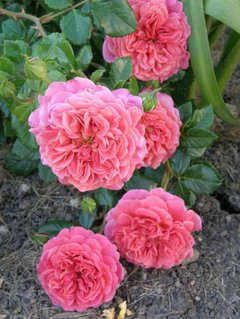
The reason why octopus canes Austins like L.D. BraithWaite and Golden Cel. are prone to blackspots: these roots are too long and deep, thus cannot take poor drainage and tons of rain. These roses get too big and demand ungodly amount of water and fertilizer to stay healthy. For Golden Cel. to stay healthy as own root, I need to dig a 3' x 3' hole.The ones that I can root easily: Carding Mill, Golden Celebration, and L.D. BraithWaite are prone to blackspots. These roots produce acid so they root easily, but their chunky & woody need needs fast drainage to stay healthy.
The ones that are slower to achieve band-size: W.S. 2000, Christopher Marlowe, The Dark Lady are small & compact bushes and harder to root since roots don't produce acid like the aggressive ones. These hard-to-root roses are also very healthy.
SHORT roses with SHORTER but hard roots can take tons of rain better. The Dark Lady is very small as grafted at Chicago Botanical Garden: 1.5' x 1.5' My Dark Lady is 8th-year own-root, and it's only 2' x 2'.
Christopher Marlowe is even shorter 1.5' x 2' .. never see blackspots on Chris, and rarely with The Dark Lady (only if I fail to water or fertilize it).
Versigny is healthy & small & compact as own-root. Versigny is also hard to root. I miss its fabulous apricot-pie scent. Versigny died twice in my zone 5a thanks to my not digging deep enough for drainage. If I buy it again, I will keep it in an air-pot and winterize in my unheated garage, zone 5a so bunnies won't eat it (like Annie L. McDowell).
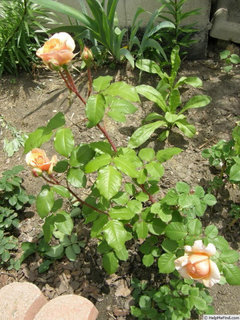
Versigny is the best rose for the vase ever, lasting 5+ days. The peachy pink is Evelyn, and oranges are Versigny: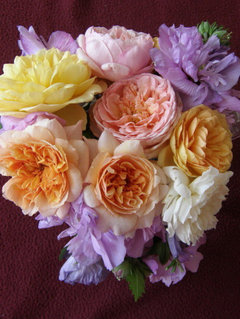
Below bouquet has my most fav. roses for the vase: orange Versigny, red Firefighter, white Bolero, and pink Liv. Tyler. All don't survive long in my zone 5a winter, and I constantly have to replace them. They are worth it for the most wonderful scents (except for Liv Tyler weird sour apricot and mothball scent).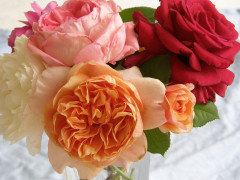







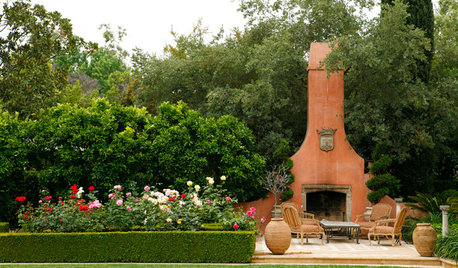

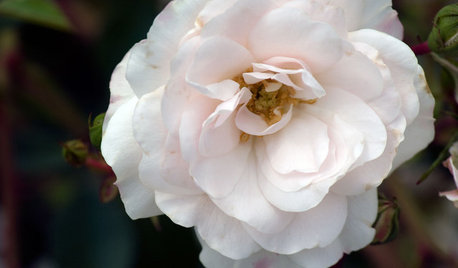






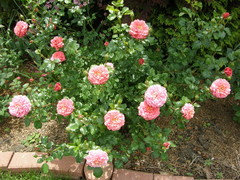
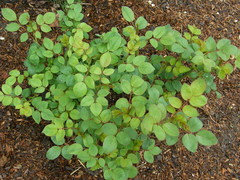
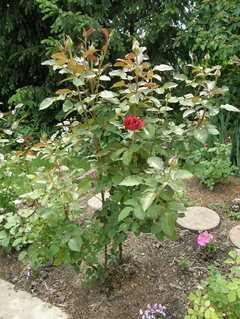
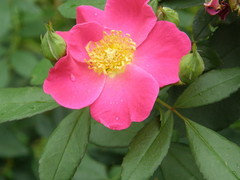
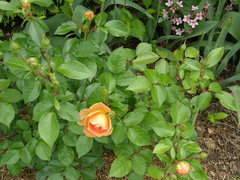
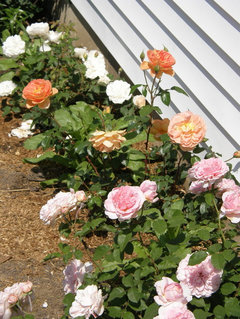
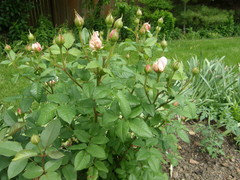
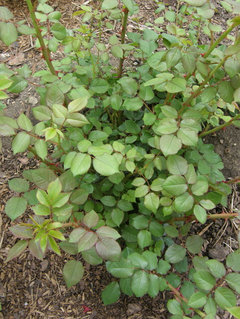
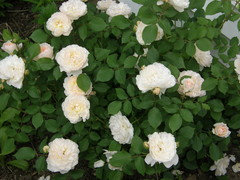
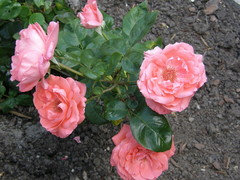
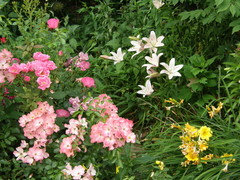
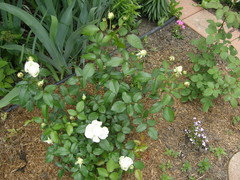
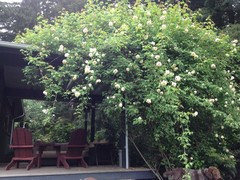
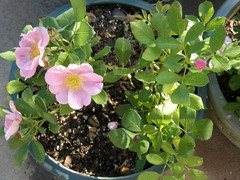
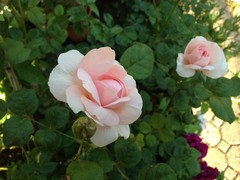
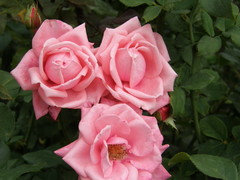

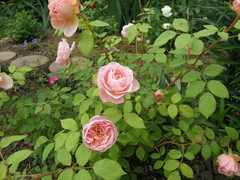
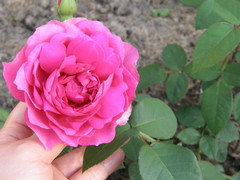
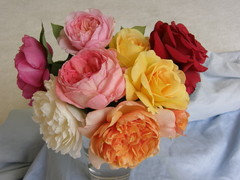
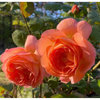
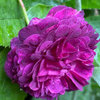

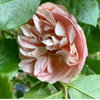
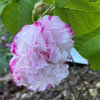
strawchicago z5Original Author